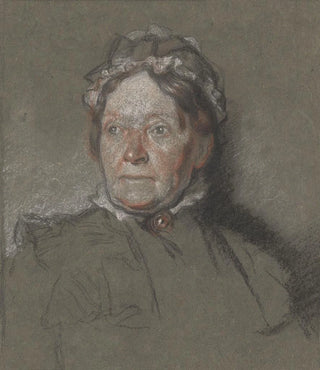Art print | Portrait of Annie, the artist's mother - William Orpen


View from behind

Frame (optional)
In the vast world of art, some works transcend the mere frame to become poignant testimonies of human relationships. "Portrait of Annie, the artist's mother - William Orpen" is one of those creations that, through its emotional depth, invites us to explore the intimacy of a mother-son relationship. Through this portrait, Orpen does not merely depict his mother; he captures the very essence of her being, her thoughts, and her emotions, offering the viewer a window into the soul of this woman. This painting, executed with undeniable technical mastery, leaves no one indifferent and prompts reflection on family bonds and memory.
Style and uniqueness of the work
William Orpen's style is distinguished by a realistic approach, while incorporating impressionist elements that lend his works a certain lightness. In "Portrait of Annie," the chosen color palette, ranging from warm tones to delicate shades, creates an intimate and warm atmosphere. Orpen excels in rendering textures, whether through his mother's clothing or the softness of her skin. Every detail is carefully considered, every shadow skillfully placed, giving the work depth and an almost sculptural dimension. The mother's posture, slightly turned toward the viewer, evokes both tenderness and vulnerability, while her gaze, imbued with wisdom, seems to tell a story that only a son could truly understand.
The artist and his influence
William Orpen, an emblematic figure of early 20th-century British painting, established himself through his talent and sensitivity. Trained at the Royal Academy, he was influenced by various artistic movements, from realism to impressionism, which is reflected in his work. Orpen was also a privileged witness to the upheavals of his time, notably during the First World War, and this profoundly marked his art. His approach to portraiture, where he seeks to capture not only physical appearance but also the soul of his subjects, makes him a pioneer in the field. "Portrait of Annie" perfectly illustrates this

Matte finish

View from behind

Frame (optional)
In the vast world of art, some works transcend the mere frame to become poignant testimonies of human relationships. "Portrait of Annie, the artist's mother - William Orpen" is one of those creations that, through its emotional depth, invites us to explore the intimacy of a mother-son relationship. Through this portrait, Orpen does not merely depict his mother; he captures the very essence of her being, her thoughts, and her emotions, offering the viewer a window into the soul of this woman. This painting, executed with undeniable technical mastery, leaves no one indifferent and prompts reflection on family bonds and memory.
Style and uniqueness of the work
William Orpen's style is distinguished by a realistic approach, while incorporating impressionist elements that lend his works a certain lightness. In "Portrait of Annie," the chosen color palette, ranging from warm tones to delicate shades, creates an intimate and warm atmosphere. Orpen excels in rendering textures, whether through his mother's clothing or the softness of her skin. Every detail is carefully considered, every shadow skillfully placed, giving the work depth and an almost sculptural dimension. The mother's posture, slightly turned toward the viewer, evokes both tenderness and vulnerability, while her gaze, imbued with wisdom, seems to tell a story that only a son could truly understand.
The artist and his influence
William Orpen, an emblematic figure of early 20th-century British painting, established himself through his talent and sensitivity. Trained at the Royal Academy, he was influenced by various artistic movements, from realism to impressionism, which is reflected in his work. Orpen was also a privileged witness to the upheavals of his time, notably during the First World War, and this profoundly marked his art. His approach to portraiture, where he seeks to capture not only physical appearance but also the soul of his subjects, makes him a pioneer in the field. "Portrait of Annie" perfectly illustrates this






